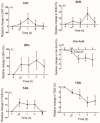Kinetic Profile of Urine Metabolites after Acute Intake of a Phenolic Compounds-Rich Juice of Juçara (Euterpe edulis Mart.) and Antioxidant Capacity in Serum and Erythrocytes: A Human Study
- PMID: 37298506
- PMCID: PMC10253860
- DOI: 10.3390/ijms24119555
Kinetic Profile of Urine Metabolites after Acute Intake of a Phenolic Compounds-Rich Juice of Juçara (Euterpe edulis Mart.) and Antioxidant Capacity in Serum and Erythrocytes: A Human Study
Abstract
The juçara palm tree produces a small spherical and black-purple fruit similar to açaí. It is rich in phenolic compounds, especially anthocyanins. A clinical trial evaluated the absorption and excretion of the main bioactive compounds in urine and the antioxidant capacity in serum and erythrocytes of 10 healthy subjects after juçara juice intake. Blood samples were collected before (0.0 h) and 0.5 h, 1 h, 2 h, and 4 h after a single dose (400 mL) of juçara juice, while urine was collected at baseline and 0-3 and 3-6 h after juice intake. Seven phenolic acids and conjugated phenolic acids were identified in urine deriving from the degradation of anthocyanins: protocatechuic acid, vanillic acid, vanillic acid glucuronide, hippuric acid, hydroxybenzoic acid, hydroxyphenylacetic acid, and ferulic acid derivative. In addition, kaempferol glucuronide was also found in urine as a metabolite of the parent compound in juçara juice. Juçara juice caused a decrease in the total oxidant status of serum after 0.5 h in comparison to baseline values (p < 0.05) and increased the phenolic acid metabolites excretion. This study shows the relationship between the production of metabolites of juçara juice and the total antioxidant status in human serum, indicating evidence of its antioxidant capacity.
Keywords: Euterpe edulis; anthocyanins; antioxidant activity; phenolic compounds; urine metabolites.
Conflict of interest statement
The authors declare no conflict of interest.
Figures


Similar articles
-
Açaí (Euterpe oleracea Mart.) and juçara (Euterpe edulis Mart.) juices improved HDL-c levels and antioxidant defense of healthy adults in a 4-week randomized cross-over study.Clin Nutr. 2020 Dec;39(12):3629-3636. doi: 10.1016/j.clnu.2020.04.007. Epub 2020 Apr 11. Clin Nutr. 2020. PMID: 32349893 Clinical Trial.
-
Anthocyanins, phenolic acids and antioxidant properties of Juçara fruits (Euterpe edulis M.) along the on-tree ripening process.Plant Foods Hum Nutr. 2014 Jun;69(2):142-7. doi: 10.1007/s11130-014-0406-0. Plant Foods Hum Nutr. 2014. PMID: 24570272
-
Biological activities of açaí (Euterpe oleracea Mart.) and juçara (Euterpe edulis Mart.) intake in humans: an integrative review of clinical trials.Nutr Rev. 2021 Nov 10;79(12):1375-1391. doi: 10.1093/nutrit/nuab002. Nutr Rev. 2021. PMID: 33555024 Review.
-
Valorization of Euterpe edulis Mart. agroindustrial residues (pomace and seeds) as sources of unconventional starch and bioactive compounds.J Food Sci. 2020 Jan;85(1):96-104. doi: 10.1111/1750-3841.14978. Epub 2019 Dec 24. J Food Sci. 2020. PMID: 31872872
-
An Update on the Biological Activities of Euterpe edulis (Juçara).Planta Med. 2018 May;84(8):487-499. doi: 10.1055/s-0044-101624. Epub 2018 Feb 21. Planta Med. 2018. PMID: 29466809 Review.
Cited by
-
Effects of anthocyanin supplementation on blood lipid levels: a systematic review and meta-analysis.Front Nutr. 2023 Aug 15;10:1207751. doi: 10.3389/fnut.2023.1207751. eCollection 2023. Front Nutr. 2023. PMID: 37649528 Free PMC article.
References
-
- Crowe F.L., Roddam A.W., Key T.J., Appleby P.N., Overvad K., Jakobsen M.U., Tjønneland A., Hansen L., Boeing H., Weikert C., et al. Fruit and vegetable intake and mortality from ischaemic heart disease: Results from the European Prospective Investigation into Cancer and Nutrition (EPIC)-Heart study. Eur. Heart J. 2011;32:1235–1243. doi: 10.1093/eurheartj/ehq465. - DOI - PMC - PubMed
-
- Del Rio D., Rodriguez-Mateos A., Spencer J.P.E., Tognolini M., Borges G., Crozier A. Dietary (Poly)Phenolics in Human Health: Structures, Bioavailability, and Evidence of Protective Effects Against Chronic Diseases. Antioxid. Redox Signal. 2013;18:1818–1892. doi: 10.1089/ars.2012.4581. - DOI - PMC - PubMed
-
- Centers for Disease Control and Prevention (CDS) State Indicator Report on Fruits and Vegetables. [(accessed on 27 October 2020)];2018 Available online: http://www.cdc.gov/nutrition/downloads/fruits-vegetables/2018/2018-fruit....
Publication types
MeSH terms
Substances
Grants and funding
- MCT/CNPq 14/2012 under Grant [number 483929/2012-3], protocol number 8454-189979648178 and 153453/2012-5/National Council for Scientific and Technological Development
- Finance Code 001/Coordenação de Aperfeicoamento de Pessoal de Nível Superior
- 2013/07914-8/São Paulo Research Foundation
- 165753/2020-0/CNPq Scholarship - Brazil
LinkOut - more resources
Full Text Sources
Medical

